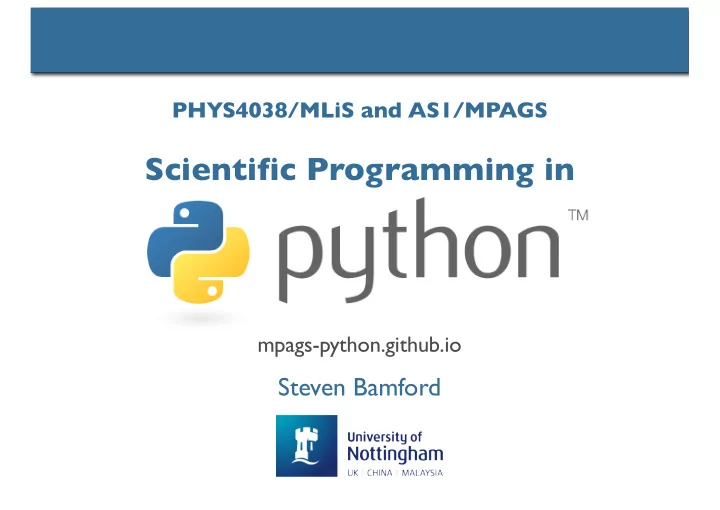

PHYS4038/MLiS and AS1/MPAGS Scientific Programming in mpags-python.github.io Steven Bamford
An introduction to scientific programming with Session 5 : Scientific Python
Scientific Python (SciPy) • Suite of numerical and scientific tools for Python • http://scipy.org/ • http://docs.scipy.org/
Scipy subpackages • cluster Clustering algorithms • constants Physical and mathematical constants • fftpack Fast Fourier Transform routines • integrate Integration and ordinary differential equation solvers • interpolate Interpolation and smoothing splines • io Input and Output # scipy submodules • linalg Linear algebra # must be explicitly • ndimage N-dimensional image processing # imported, e.g., • odr Orthogonal distance regression import scipy.fftpack • optimize Optimization and root-finding # or • signal Signal processing from scipy import stats • sparse Sparse matrices and associated routines • spatial Spatial data structures and algorithms • special Special functions • stats Statistical distributions and functions
SciPy Some simple examples: • Special functions (special) • Root finding (optimize) • Integration (integrate) • Statistics (stats) • Image processing (ndimage) • Interpolation (interpolate) • Optimisation (optimize)
Scipy – special functions • Huge number of functions, including… • Bessel functions • Gamma functions • Fresnel integrals • Hypergeometric functions • Orthogonal polynomials e.g., Bessel functions of order 1, 2, 3 >>> from scipy import special >>> x = np.arange(0, 10.001, 0.01) >>> for alpha in range(3): ... y = special.jv(alpha, x) ... plt.plot(x, y, label=r'$J_%i$'%alpha) >>> plt.hlines(0, 0, 10) >>> plt.legend()
Scipy – root finding • Accurate automatic root-finding using MINPACK >>> from scipy.optimize import fsolve # n-dimensional root finder >>> from scipy.special import jv Define a function to solve First argument is variable (or array of variables) of interest >>> def f(z, a1, a2): ... return jv(a1, z) - jv(a2, z) ... >>> fsolve(f, 2.5, args=(1, 2)) array([ 2.62987411]) >>> fsolve(f, 6, args=(1, 2)) array([ 6.08635978]) >>> plt.fill_between(x, special.jv(1, x), special.jv(2, x), where=((x > 2.630) & (x < 6.086)), color=“peru”)
Scipy – integration • Accurate automatic integration using QUADPACK • including uncertainty estimate >>> from scipy.integrate import quad # one-dimensional integration Using previous function (first argument is variable of interest) >>> r = fsolve(f, (2.5, 6), args=(1, 2)) >>> print r [ 2.62987411 6.08635978] >>> quad(f, r[0], r[1], args=(1, 2)) (-0.98961158607157, 1.09868956829247e-14) • Can specify limits at infinity (-np.inf, np.inf) >>> quad(exp, -np.inf, 0) (1.0000000000000002, 5.842606742906004e-11)
Scipy – integration • QUADPACK and MINPACK routines provide warning messages • Extra details returned if parameter full_output=True >>> quad(tan, 0, pi/2.0-0.0001) (9.210340373641296, 2.051912874185855e-09) >>> quad(tan, 0, pi/2.0) Warning: Extremely bad integrand behavior occurs at some points of the integration interval. (38.58895946215512, 8.443496712555953) >>> quad(tan, 0, pi/2.0+0.0001) Warning: The maximum number of subdivisions (50) has been achieved. If increasing the limit yields no improvement it is advised to analyze the integrand in order to determine the difficulties. If the position of a local difficulty can be determined (singularity, discontinuity) one will probably gain from splitting up the interval and calling the integrator on the subranges. Perhaps a special-purpose integrator should be used. (6.896548923283743, 2.1725421039565056)
Scipy – statistics • Probability distributions • including: norm, chi2, t, expon, poisson, binom, boltzmann, … • methods: • rvs – return array of random variates • pdf – probability density function >>> lambda = 10 • cdf – cumulative density function >>> p = stats.poisson(lambda) • ppf – percent point function • … and many more # P(n > 20) >>> 1 – p.cdf(20) 0.0015882606618580573 • Statistical functions • including: # N: P(n < N) = 0.05, 0.95 >>> p.ppf((0.05, 0.95)) • mean, median, skew, kurtosis, … array([ 5., 15.]) • normaltest, probplot, … # true 95% CI bounds on lambda • pearsonr, spearmanr, wilcoxon, … >>> stats.gamma.ppf((0.025, 0.975), • ttest_1samp, ttest_ind, ttest_rel, … lambda+0.5, 1) • kstest, ks_2samp, … array([ 6.14144889, 18.73943795])
Scipy – statistics >>> x = stats.norm.rvs(-1, 3, size=30) # specify pdf parameters >>> n = stats.norm(1, 3) # create 'frozen' pdf >>> y = n.rvs(20) >>> z = n.rvs(50) >>> p = plt.subplot(121) >>> h = plt.hist((x, y), normed=True, histtype='stepfilled', alpha=0.5) >>> p = plt.subplot(122) >>> h = plt.hist((x, y), histtype='step', cumulative=True, normed=True, bins=1000) >>> stats.ks_2samp(x, y) (0.29999999999999999, 0.18992875018013033) >>> stats.ttest_ind(x, y) (-1.4888787966012809, 0.14306062943339182) >>> stats.ks_2samp(x, z) (0.31333333333333335, 0.039166429989206733) >>> stats.ttest_ind(x, z) (-2.7969511393118509, 0.0064942129302196124) >>> stats.kstest(x, stats.norm(1, 3).cdf) (0.3138899035681928, 0.0039905619713858087)
Scipy – filtering and interpolation Notebook filtering and interpolation example [link to online notebook]
Scipy – optimisation • Local optimisation • minimize function • lots of options, different optimizers, constraints • Least squares fitting • curve_fit • uses Levenberg-Marquardt algorithm Details at http://docs.scipy.org/doc/scipy/reference/tutorial/optimize.html Notebook fitting example [link to online notebook]
Other / more options…
astropy • Astronomical constants, units, times and dates • Astronomical coordinate systems • Cosmology calculations • Virtual Observatory integration • Astronomy specific additions to numpy/scipy tools: • n-dimensional datasets, tables • model fitting, convolution, filtering, statistics • Open source, on GitHub
RPy • http://rpy.sourceforge.net/ • Wraps R – a statistics analysis language • very powerful • used by statisticians • many advanced stats capabilities • quite specialised • http://www.r-project.org
PyGSL • Python wrappers of GNU Scientific Library functions • PyGSL: http://pygsl.sourceforge.net/ • GSL: http://www.gnu.org/software/gsl/ • Incomplete documentation for Python functions, but almost all of GSL is wrapped, so refer to GSL documentation. • Most functionality implemented in SciPy • or other, more Pythonic, tools • comprehensive and sometimes more tested
PHYS4038/MLiS and AS1/MPAGS Scientific Programming in mpags-python.github.io Steven Bamford
Recommend
More recommend